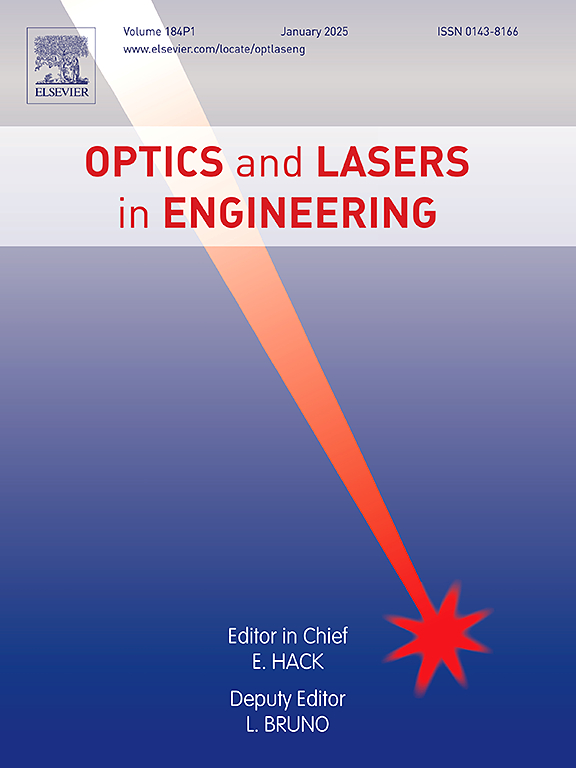使用光纤生物传感器进行糖尿病视网膜病变生物标志物的无标签多路检测:走向实验室
IF 3.5
2区 工程技术
Q2 OPTICS
引用次数: 0
摘要
糖尿病视网膜病变是糖尿病患者的常见病,常伴有水肿、硬渗出物形成、出血等并发症,最终导致视力丧失。在早期阶段发现这种疾病可以提高治疗的有效性并保护患者的视力。使用更可靠的方法测量糖尿病视网膜病变相关生物标志物的水平是另一种有前途的诊断方法。光纤生物传感器由于其高性能、微型尺寸和无标签检测特性,在提供经济实惠的平台方面越来越受欢迎。这些特性使它们成为本研究中用于生物标志物多路原位检测的生物传感器的首选传感器。在这里,我们报告了一种基于光纤的生物传感器,它是基于简单制造的半分布式干涉测量传感器。制作完成后,选择敏感传感器,用两种针对糖尿病视网膜病变相关生物标志物的抗体进一步功能化,以生产生物传感器。生物标志物的检测在静态条件下的人工泪液中进行评估,最重要的是在模拟自然泪液流动的动态条件下进行评估。这种方法允许无标记监测强度随分析物特异性结合在生物传感器表面的浓度增加而变化。即脂质体蛋白1的检出限为5.98 ng/mL,血管内皮生长因子的检出限为26.6 fg/mL。所设计的生物传感器可以成为开发一种新的眼病早期临床诊断方法的基础。本文章由计算机程序翻译,如有差异,请以英文原文为准。

Label-free multiplexed detection of diabetic retinopathy biomarkers using fiber optic biosensors: Towards lab-in-the-tear
Diabetic retinopathy is a common disease in diabetic patients accompanied by such complications as edema, formation of hard exudates, hemorrhages, and eventually vision loss. Detection of the disease at an early stage could increase the effectiveness of therapy and preserve the patient's vision. Measuring the levels of diabetic retinopathy-associated biomarkers using more reliable methods is an alternative and promising way of diagnosis. Optical fiber biosensors have gained rising popularity in providing affordable platforms due to their high-performance capabilities, miniature size, and label-free nature of detection. These properties made them a sensor of choice for developing biosensors for a multiplexed in situ detection of biomarkers in this study. Here, we report an optical fiber-based biosensor that is based on simply fabricated semi-distributed interferometry sensors. After fabrication, sensitive sensors were chosen for further functionalization with two antibodies against biomarkers relevant to diabetic retinopathy to produce biosensors. The detection of the biomarkers was evaluated in artificial tear fluid in static conditions and most importantly in dynamic conditions simulating natural tear flow. This method allowed label-free monitoring of the intensity change with the increasing concentrations of analytes specifically binding on the biosensor surface. Namely, it was possible to detect lipocalin 1 protein with a limit of detection of 5.98 ng/mL and vascular endothelial growth factor down to 26.6 fg/mL. The designed biosensors can become the basis for developing a new method for a clinical diagnosis of eye diseases at early stages of development.
求助全文
通过发布文献求助,成功后即可免费获取论文全文。
去求助
来源期刊

Optics and Lasers in Engineering
工程技术-光学
CiteScore
8.90
自引率
8.70%
发文量
384
审稿时长
42 days
期刊介绍:
Optics and Lasers in Engineering aims at providing an international forum for the interchange of information on the development of optical techniques and laser technology in engineering. Emphasis is placed on contributions targeted at the practical use of methods and devices, the development and enhancement of solutions and new theoretical concepts for experimental methods.
Optics and Lasers in Engineering reflects the main areas in which optical methods are being used and developed for an engineering environment. Manuscripts should offer clear evidence of novelty and significance. Papers focusing on parameter optimization or computational issues are not suitable. Similarly, papers focussed on an application rather than the optical method fall outside the journal''s scope. The scope of the journal is defined to include the following:
-Optical Metrology-
Optical Methods for 3D visualization and virtual engineering-
Optical Techniques for Microsystems-
Imaging, Microscopy and Adaptive Optics-
Computational Imaging-
Laser methods in manufacturing-
Integrated optical and photonic sensors-
Optics and Photonics in Life Science-
Hyperspectral and spectroscopic methods-
Infrared and Terahertz techniques
 求助内容:
求助内容: 应助结果提醒方式:
应助结果提醒方式:


